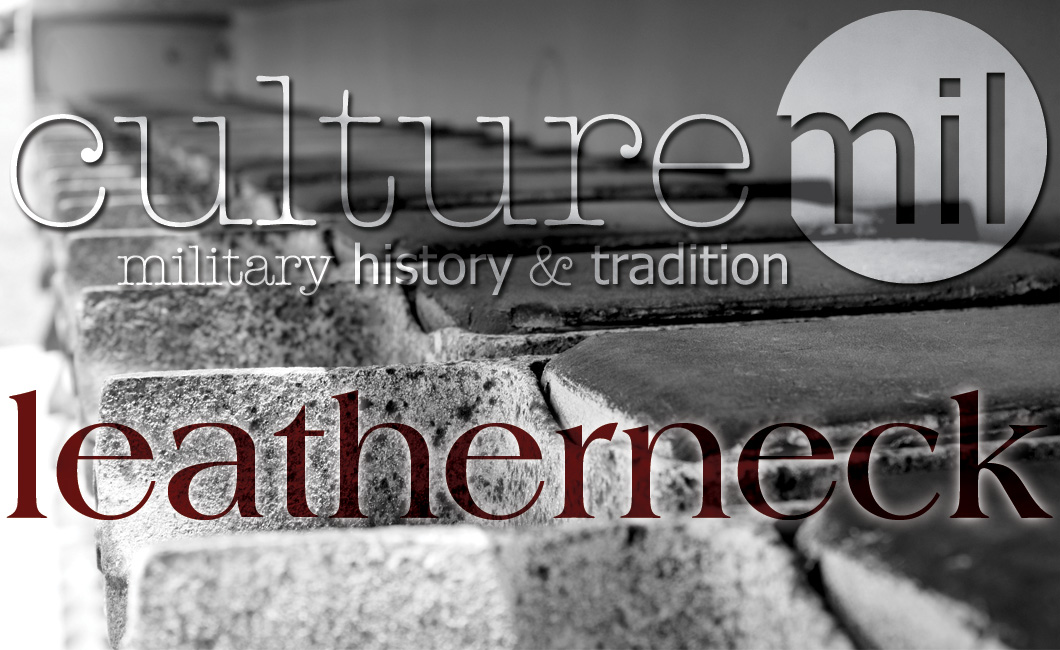- Protection to the neck and critical veins from cutlass slashes
- Maintaining military bearing by forcing the wearer to keep the head erect
Written by Jenifer Chrisman on March 28, 2016.
leatherneck
leath·er·neck [leth-er-nek]
noun, informal : plural, leathernecks
definition, a US marine.
The Naval Committee of the Second Continental Congress published new Continental Marines uniform regulations on September 5, 1776. The uniforms consisted of a green coat with white facings, including lapels, cuffs and coat lining, and a high leather collar called “The Stock,” buff breeches and black gaiters (a shoe or overshoe extending to the ankle or above). The Stock, worn by officers and enlisted alike, was approximately three and a half inches high and served a dual purpose:
There are no clear, verifiable facts as to when the Marines received the moniker “Leatherneck.” Some believe Sailors serving shipboard with Marines were the first to use it due to the Marines precise military bearing. Others believe the term originated during the Barbary Wars as Marines had the additional protection from their heavy collars.
The Stock remained part of the Marines uniform until 1872, when it was replaced with a black glazed strip of leather worn on the inside front of the dress uniform collar. In today’s modern dress uniform, the last vestiges of the Stock can be seen in the stiff cloth tab behind the front of the collar.
The name Leatherneck expanded to not only represent Marines but to inform them; two enlisted Marines, stationed at Quantico, Virginia, wanted to start a newspaper for themselves and their fellow Marines. With assistance from the Army-Navy YMCA, the two men, on their own time, published the first Quantico Leatherneck on November 17, 1917, highlighting features and stories specific to the interest of the Marines, as well as chronicling the Corps. Approved by the base commander and funded by advertisements from local merchants, the paper quickly became popular.
Quantico was dropped from the title in 1918. And by 1920 the Marine Corps stepped in to ensure the paper continued, as Marines are subject to transfer. Major General John A. Lejeune, Commandant of the Marine Corps at the time, not only wanted the newspaper to be available to all Marines, but also wanted to raise the education and knowledge level of the Corps as a whole. The Marine Corps Institute (MCI) was formed in Marine Barracks, Washington D.C., and the Leatherneck was moved from Quantico and placed under their supervision.
The Leatherneck changed again in 1925 from a newspaper format to a magazine format, then became autonomous in 1943 when the Leatherneck Association was founded. Still mostly staffed by active-duty Marines until 1972, the Leatherneck moved back to Quantico. The Leatherneck Association merged with the Marine Corps Association in 1976, which has become a beneficial partnership for both organizations. Despite all the changes they have faced through the years, their mission remains the same…to be the magazine of the Marines – yesterday, today and tomorrow.
From moniker to newspaper to magazine, Leatherneck has had a long and proud tradition within the Marine Corps. Regardless of how the name Leatherneck came about, for those who serve in the Corps, being called a Leatherneck is a source of pride. Once a Marine, Always a Marine.
Sources:
• http://www.usmcmuseum.com/Museum_LoreCorps.asp
• http://www.usmcpress.com/heritage/usmc_terms.htm
• http://www.grunt.com/corps/scuttlebutt/marine-corps-stories/the-term-leatherneck/
• https://www.mca-marines.org/leatherneck/leatherneck-legacy
• http://www.newyorkmarinecadets.org/files/USMC_Uniforms.pdf




